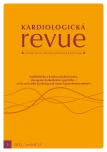Hypertriglyceridemia and cardiovascular risk
Authors:
T. Štulc
Published in:
Kardiol Rev Int Med 2012, 14(3): 157-160
Category:
Overview
Hypertriglyceridemia is a common metabolic disorderwhich is mostly associated with other components of so-called atherogenic dyslipidemia, inparticularwith HDL-cholesterol reduction. Both experimental and epidemiological studies show thatpathogenetic effects of hypertriglyceridemia are prevailingly indirect – they are intermediated by an increasedproduction of “small dense” LDL particles and remnant particles and by a reduced concentrationof HDL-cholesterol. Therefore, hypertriglyceridemia primarily marks atherogenic changes ofvarious lipoprotein particles and often also the occurrence of other components of the metabolic syndrome.The basis of hypertriglyceridemia treatment are dietary and regimen measures; if their efficacyis insufficient, the administration of fibrates or niacin can be considered.
Keywords:
triglycerides – atherogenic dyslipidemia – cardiovascular risk – atherosclerosis – epidemiology –clinical trials
Sources
1. Chapman MJ, Ginsberg HN, Amarenco P et al. European Atherosclerosis Society Consensus Panel. Triglyceriderich lipoproteins and high-density lipoprotein cholesterol in patients at high risk of cardiovascular disease: evidence and guidance for management. Eur Heart J 2011; 32: 1345–1361.
2. Miller M, Stone NJ, Ballantyne C et al. American Heart Association Clinical Lipidology, Thrombosis, and Prevention Committee of the Council on Nutrition, Physical Activity, and Metabolism; Council on rteriosclerosis,
Thrombosis and Vascular Biology; Council on Cardiovascular Nursing; Council on the Kidney in Cardiovascular Disease. Triglycerides and cardiovascular disease: a scientific statement from the American Heart Association. Circulation 2011; 123: 2292–2333.
3. Hokanson JE, Austin MA. Plasma triglyceride level is a risk factor for cardiovascular disease independent of high-density lipoprotein cholesterol level: a metaanalysis of population-based prospective studies.
J Cardiovasc Risk 1996; 3: 213–219.
4. Sarwar N, Danesh J, Eiriksdottir G et al. Triglycerides and the risk of coronary heart disease: 10,158 incident cases among 262,525 participants in 29 Western prospective studies. Circulation 2007; 115: 450–458.
5. Di Angelantonio E, Sarwar N, Perry P et al. Emerging Risk Factors Collaboration. Major lipids, apolipoproteins, and risk of vascular disease. JAMA 2009; 302: 1993–2000.
6. Nordestgaard BG, Benn M, Schnohr P et al. Nonfasting triglycerides and risk of myocardial infarction, ischemic heart disease, and death in men and women. JAMA 2007; 298: 299–308.
7. Manninen V, Tenkanen L, Koskinen P et al. Joint effects of serum triglyceride and LDL cholesterol and HDL cholesterol concentrations on coronary heart disease risk in the Helsinki Heart Study. Implications for
treatment. Circulation 1992; 85: 37–45.
8. Robins SJ, Collins D, Wittes JT et al. VA-HIT Study Group. Veterans Affairs High-Density Lipoprotein Intervention Trial. Relation of gemfibrozil treatment and lipid levels with major coronary events: VA-HIT: a randomized controlled trial. JAMA 2001; 285: 1585–1591.
9. The BIP Study Group. Secondary prevention by raising HDL cholesterol and reducing triglycerides in patients with coronary artery disease. The Bezafibrate Infarction Prevention (BIP) Study. Circulation 2000;
102: 21–27.
10. Scott R, O’Brien R, Fulcher G et al. Fenofibrate Intervention and Event Lowering in Diabetes (FIELD) Study Investigators. Effects of fenofibrate treatment on cardiovascular disease risk in 9,795 individuals with type 2 diabetes and various components of the metabolic syndrome: the Fenofibrate Intervention and Event Lowering in Diabetes (FIELD) study. Diabetes Care 2009; 32: 493–498.
11. ACCORD Study Group. Effects of combination lipid therapy in type 2 diabetes mellitus. N Eng J Med 2010; 362: 1563–1574.
12. Perk J, De Backer G, Gohlke H et al. European Guidelines on cardiovascular disease prevention in clinical practice (version 2012): The Fifth Joint Task Force of the European Society of Cardiology and Other Societies on Cardiovascular Disease Prevention in Clinical Practice (constituted by representatives of nine societies and by invited experts). Developed with the special contribution of the EuropeanAssociation
for Cardiovascular Prevention & Rehabilitation (EACPR). Eur Heart J 2012; 33: 1635–1701. doi:10.1093/eurheartj/ehs092.
13. European Association for Cardiovascular Prevention & Rehabilitation, Reiner Z, Catapano AL, De Backer G et al. ESC/EAS Guidelines for the management of dyslipidaemias: The Task Force for the management of dyslipidaemias of the European Society of Cardiology (ESC) and the European Atherosclerosis Society (EAS). Eur Heart J 2011; 32: 1769–1818.
14. Expert Panel on Detection, Evaluation, and Treatment of High Blood Cholesterol in Adults. Executive Summary of The Third Report of The National Cholesterol Education Program (NCEP) Expert Panel on Detection, Evaluation, And Treatment of High Blood Cholesterol In Adults (Adult Treatment Panel III). JAMA 2001; 285: 2486–2497.
Labels
Paediatric cardiology Internal medicine Cardiac surgery CardiologyArticle was published in
Cardiology Review

2012 Issue 3
Most read in this issue
- Importance of determining apolipoproteins B and A-1 in clinical practice
- Ticagrelor in patients with acute coronary syndrome
- Hypertriglyceridemia and cardiovascular risk
- Troponin as a prognostic risk factor in patients hospitalized for decompensation of chronic systolic heart failure
